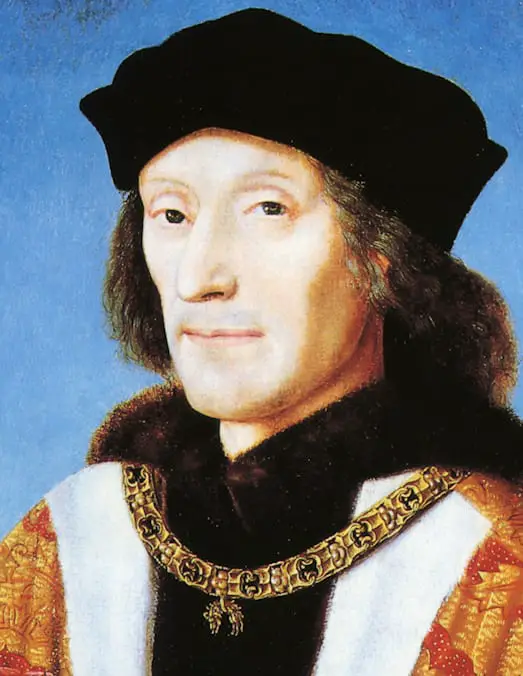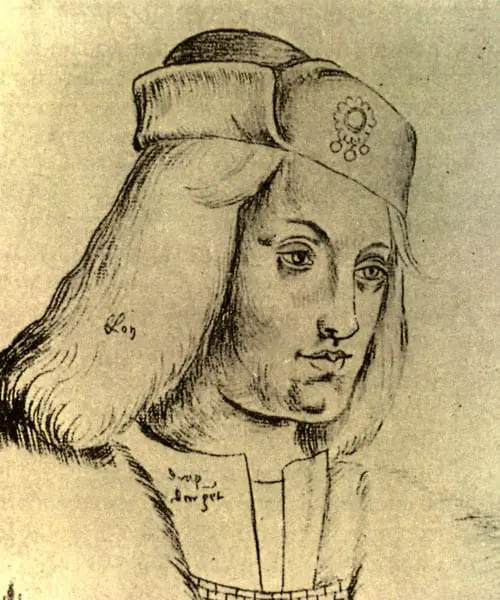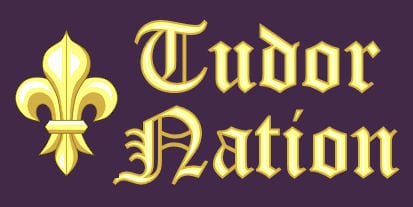King Henry VII’s Foreign Policy had four main aims:
1. Secure the throne;
2. Establish the Tudor dynasty;
3. Gain recognition from European monarchs
4. Increase revenue through foreign trade.
Henry VII’s Foreign Policy – Aim 1 – Secure the throne
Background
Henry VII had become King after defeating and killing Richard III at the Battle of Bosworth Field. However, his position was not secure.

The Wars of the Roses between rival Yorkist and Lancastrian factions had been ongoing for thirty years and Lancastrian Henry knew that Yorkist supporters would try to remove him from the throne.
King Henry VII’s foreign policy aimed to marry his children to forge European alliances which would help secure the throne.
Achievements
Marriage to Elizabeth of York
On 18th January 1486 Henry married Elizabeth of York, eldest daughter of Yorkist King Edward IV. The marriage united the houses of Lancaster and York and brought the Wars of the Roses to an end. The Tudor rose is an amalgam of the white rose of York and the red rose of Lancaster.

Two months after their marriage the royal couple embarked on a tour of the north of England. The royal couple were accompanied by a retinue that included 200 bowmen.
Henry wanted to put off any would-be Yorkist pretender to the throne. He made a great show of richness and grandeur which he hoped would inspire awe, respect and the affection of his people.
Pretenders to the throne defeated
During the early years of Henry VII’s reign the Yorkist faction put forward three pretenders to the throne.
In 1487 Lambert Simnel claimed to be Edward, Earl of Warwick, the son of Richard III’s elder brother George. As Henry had the real Earl of Warwick imprisoned in the Tower of London he was able to parade him through the streets and show that Simnel was an imposter. Simnel’s supporters were defeated at the Battle of Stoke Field, 16th June 1487.
In 1491 a more serious challenge to the throne came from Perkin Warbeck who claimed to be Richard of York, the younger of the Princes in the Tower. He gained the support of Margaret of Burgundy, James IV of Scotland and Holy Roman Emperor Maximilian.

Using diplomacy and arms, Henry succeeded in capturing Warbeck in 1497. He was executed in 1499 after escaping from the Tower of London.
A third pretender, Ralph Wulford, appeared in February 1499. He was caught and executed. The Earl of Warwick was also executed in 1499 to prevent further imposters in his name.
Succession
When Henry VII died on 21st April 1509, his son Henry succeeded as King Henry VIII without incident.
Henry VII’s Foreign Policy – Aim 2 – Establish the Tudor dynasty
Background
The Wars of the Roses had begun as a result of the weak and rule of King Henry VI. Henry VII knew that it was vital that he showed strong leadership of the country. He also knew that he needed male heirs to ensure the continuance of the new House of Tudor. Henry VII’s foreign policy included marrying his children to European princes and princesses in order to secure the future of the dynasty.
Achievements
Children
Henry VII and Elizabeth of York had seven children – 3 boys and 4 girls:
Arthur – born 1486, Margaret – born 1489, Henry – born 1491, Elizabeth – born 1492, Mary – born 1496, Edmund – born 1499, Katherine – born 1503

Marriage of Arthur to Catherine of Aragon
On 14th November 1501, Prince Arthur married Catherine of Aragon, daughter of Ferdinand and Isabella of Spain. The marriage sealed an alliance with Spain.
Marriage of Margaret to James IV of Scotland
On 8th August 1503, Margaret Tudor married King James IV of Scotland. The marriage meant that the heirs of Scotland would be of Tudor blood.
Failures
Death of Prince Arthur
The premature death of Prince Arthur in April 1502 was a serious blow for Henry VII. Prince Edmund and Princess Elizabeth had died in infancy and Henry VII now had just one surviving son. The success of the Tudor dynasty rested on the shoulders of Prince Henry. Elizabeth of York was now 36 years old and nearing the end of child-bearing.
Death of Elizabeth of York
Henry’s wife, Elizabeth of York died of complications following the birth of Princess Katherine in 1503. Henry suggested a marriage between himself and Catherine of Aragon, his son’s widow, but Catherine’s parents refused. Joan, Queen of Naples, Margaret of Savoy and Germaine de Foix were suggested as possible brides for Henry but negotiations were unsuccessful.
Henry VII’s Foreign Policy – Aim 3 – Recognition by European monarchs
Background

Having taken the throne through victory in battle, Henry needed to ensure that foreign monarchs supported the new dynasty.
France and Scotland were traditional allies through the Auld Alliance, while Spain, Netherlands and Burgundy were part of the Hapsburg Empire.
Henry VII’s foreign policy was designed to place England at the centre of European affairs without necessarily committing to costly wars.
Achievements
Treaty of Redon 1489
This was a treaty of support between Brittany and England made in February 1489. Brittany was under threat of invasion from France and Henry wanted to maintain the independence of Brittany.
Treaty of Dordrecht 1489
This was a treaty of alliance between Henry VII and Holy Roman Emperor Maximilian. They agreed to ally against France, in support of Brittany.
Treaty of Medina del Campo 1489
This treaty was signed 27th March 1489 and set out the terms for the marriage of Prince Arthur to Catherine of Aragon, daughter of King Ferdinand and Queen Isabella of Spain.
Treaty of Etaples 1492
Although England had been unable to stop France from annexing Brittany, this treaty agreed a peace between England and France. Included in the treaty was a clause where each King agreed not to give assistance to the other’s enemies. This clause meant that France would give no support to Yorkist pretenders.
Holy League of Venice 1496
England joined the Papal States, Venice, Naples, Spain, Milan, the Holy Roman Empire, Florence and Mantua against France who had invaded Italy. Joining the alliance showed England a major player on the European stage and gained recognition from the Pope.
Treaty of Ayton 1497
This treaty agreed a seven-year peace between England and Scotland. It was agreed that the treaty would be sealed by the marriage of James IV and Henry’s daughter Margaret. The peace ended Scotland’s support for the pretender Perkin Warbeck who was expelled from Scotland.
Treaty of Perpetual Peace 1502
This treaty extended the peace between England and Scotland for the lifetime of both monarchs and their heirs. It also agreed an end to border disputes and included a clause that neither monarch would make war on each other or assist each other’s enemies. Arrangements for the marriage of James IV to Margaret Tudor were also agreed.
Treaty of Aachen 1502
Henry VII agreed a treaty with Holy Roman Emperor, Maximilian. Henry promised to give Maximilian 10,000 crowns towards his war with Turkey and Maximilian agreed to stop giving refuge to Henry’s enemies, notably Edmund de la Pole.
Betrothal of Prince Henry and Catherine of Aragon
On 25th June 1503 Prince Henry and Catherine of Aragon were formally betrothed. The Spanish monarchs had been keen to maintain the alliance with England.
Treaty of Windsor 1506
This secret treaty between Henry VII and Philip of Burgundy was concluded. Both parties agreed to ally themselves unconditionally. Henry agreed to allow Philip free passage through the English Channel so that he could easily travel between Spain and the Netherlands. A marriage between Henry’s daughter Mary and Philip’s son Charles was also discussed.

Betrothal of Princess Mary
On 21st December 1507, Princess Mary was formally betrothed to Charles, son of Philip I of Spain.
Failures
Death of Prince Arthur
Prince Arthur had married Catherine of Aragon in November 1501. At the time of Arthur’s death the second portion of her dowry remained unpaid. Henry’s insistence that the remainder be paid and Spain’s refusal to comply led to a souring of relations between England and Spain.
Pretenders to the throne
Margaret of Burgundy was the sister of King Edward IV and a Yorkist. She supported the claim to the English throne of both Lambert Simnel and Perkin Warbeck and did not recognise Henry as King. Warbeck also gained the support of James IV of Scotland and Holy Roman Emperor Maximilian.

Delayed Marriage of Prince Henry and Catherine of Aragon
Despite agreeing terms for the marriage of Prince Henry and Catherine of Aragon, Henry VII continually stalled. The death of Isabella of Spain in 1504 made an alliance with Spain less favourable.
Scotland
Despite the agreement of the Treaty of Perpetual Peace 1502, the Scots continued to make border raids into England.
Henry VII’s Foreign Policy – Aim 4 – Increase revenue through foreign trade and import duties
Background
Henry knew that good relations with foreign powers could result in trade agreements which would be advantageous for England.
Import duties from trade would help to increase revenue.
Negotiating advantageous terms for England was a vital component of King Henry VII’s foreign policy.

Achievements
Netherlands
The trade agreement, Intercursus Magnus was signed by between England and the Netherlands in 1496. It was negotiated by Richard Foxe and provided for a renewal of trade between the two countries and agreed customs duties. A clause was added to the treaty which stated that neither country was to aid the other’s rebels and it was agreed that if Margaret of Burgundy continued to give aid to Henry’s enemies (namely Perkin Warbeck) then Philip of Burgundy would take action.
In May 1498 the English Merchant Adventurers Company was granted a trade monopoly with the Netherlands.
Book of Rates
Produced in 1507, this was a book that listed customs duties to be paid in London.
France
In 1497 a trade alliance was agreed between England and France.
Failures
Italy
In 1492 Henry imposed fixed tariffs on all imports from Italy. The Italians retaliated by refusing to send goods to England.
Burgundy
In 1493, Henry banned all trade with Burgundy due to Margaret of Burgundy’s continued support for the pretender, Perkin Warbeck.
Published Oct 15, 2020 @ 7:35 pm – Updated – Dec 7 2024
Harvard Reference for King Henry VII’s Foreign Policy?
Heather Y Wheeler. (2020 – 2025). What was King Henry VII’s Foreign Policy? Available: https://www.tudornation.com/what-was-king-henry-viis-foreign-policy Last accessed July 1st, 2025
